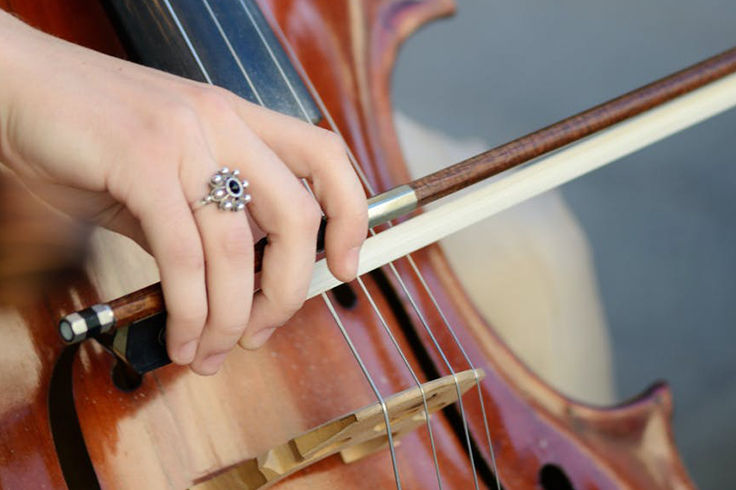Why the right technique for a violin bow is important?
- stradivaristringss
- Dec 6, 2024
- 4 min read
Mastering the violin is a multifaceted endeavor, and one of the most crucial aspects is the bowing technique. The right technique for a violin bow is paramount because it directly affects the quality of sound, intonation, and expressiveness of the music played. Proper bowing ensures a full, rich tone and allows for greater control and nuance in performance. Conversely, poor bowing technique can lead to a weak, scratchy sound and hinder a violinist’s ability to play accurately and expressively. This guide will explore why the right technique is essential and provide practical steps to master the violin bow.
Sound quality:
The violin bow is the tool that draws sound from the violin, and the way it is used significantly impacts the instrument's tone. Proper technique ensures that the bow hair makes optimal contact with the strings, producing a full and resonant sound. Incorrect bowing, such as too much or too little pressure, improper bow speed, or incorrect angle, can result in a sound that is either too harsh or too faint.
Clarity:
A good bowing technique is essential for maintaining clear and precise intonation. The evenness of the bow stroke, the consistency of pressure, and the speed all contribute to producing a clean and distinct sound. Without proper technique, notes may sound fuzzy or unclear, and rapid passages may become muddled.

Expressions:
The ability to convey emotion through music is a vital skill for any violinist. Proper bowing technique allows for dynamic control, enabling a player to execute crescendos, decrescendos, and various articulations effectively. Mastery of the bow also allows for expressive techniques such as vibrato to be executed more fluidly, adding depth and emotion to the performance.
Technical precision:
Many advanced violin techniques, such as spiccato, staccato, and legato, rely heavily on the bowing technique. Mastery of these techniques requires precise control over the violin bow, which can only be achieved through proper practice and understanding of the correct methods. Poor technique can limit a player's ability to perform these techniques accurately, restricting their repertoire and overall skill level.
How to master a violin bow?
Proper Bow Hold
The foundation of a good bowing technique begins with the bow hold. A proper bow hold ensures flexibility and control, allowing for smooth and efficient movement. Here are the key elements:
Thumb Placement:
The thumb should be placed on the underside of the violin bow stick, slightly bent and positioned between the frog and the grip.
Finger Placement:
The index finger should rest on the bow stick, the middle finger opposite the thumb, and the ring finger and pinky should lightly touch the bow.
Relaxation:
Ensure that the fingers and wrist are relaxed, avoiding any tension that can restrict movement.

Bowing Arm Mechanics
Understanding the mechanics of the bowing arm is crucial for mastering the violin bow. The movement should originate from the shoulder, with the elbow and wrist acting as flexible joints that follow the shoulder's lead. Here are some tips:
Shoulder Movement:
The shoulder should initiate the violin bow stroke, ensuring that the movement is smooth and controlled.
Elbow and Wrist:
The elbow should be slightly raised, allowing for fluid movement. The wrist should remain flexible, absorbing any shocks and maintaining a smooth bow stroke.
Bow Path:
The violin bow should move parallel to the bridge, maintaining a consistent angle with the strings.
Bow Pressure and Speed
Control over violin bow pressure and speed is essential for producing a consistent and quality sound. Here’s how to achieve it:
Pressure:
Apply even pressure throughout the violin bow stroke. Too much pressure can produce a harsh sound, while too little can result in a weak tone.
Speed:
Adjust the speed of the bow according to the dynamics of the music. A faster bow speed is needed for louder passages, while a slower speed is suitable for softer sections.

Practice Techniques
Regular practice is crucial for mastering the violin bow. Here are some effective practice techniques:
Long Tones:
Practice playing long, sustained notes to develop control over violin bow pressure and speed. Focus on maintaining a steady sound throughout the stroke.
Scales and Arpeggios:
Playing scales and arpeggios helps develop coordination between the bowing arm and the fingers on the fingerboard. Pay attention to the evenness of the bow stroke and the clarity of each note.
Etudes and Exercises:
Specific bowing exercises, such as those found in etude books, are designed to develop various aspects of the bowing technique. Incorporate these into your practice routine to address specific challenges.
Patience and Persistence
Mastering the violin bow takes time and consistent effort. Be patient with your progress and persistent in your practice. Set small, achievable goals and celebrate your improvements along the way.
Conclusion:
So, now that you have clearly understood the reasons why the violin bow is known to be one of the most important aspects of the instrument, it is important that you start looking for an institution from which you can learn the proper technique and become a master. While there are several institutions available in the market, it is better when you start looking for the best one from where you can learn this instrument. Stradivari Strings is the name of a musical institution from which you can learn this instrument. With some of the best instructors and their curriculum, they have helped several enthusiasts fulfill their dreams of becoming the wildest. So, get your enrollment done and enjoy learning this instrument.






Comments